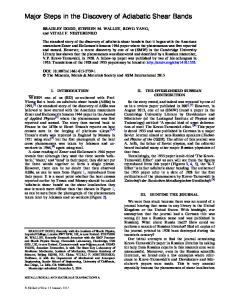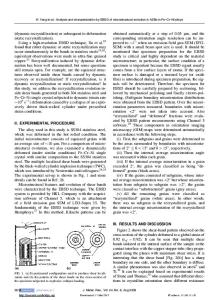Microstructural development of adiabatic shear bands formed by ballistic impact in a WELDALITE 049 alloy
- PDF / 654,167 Bytes
- 7 Pages / 612 x 792 pts (letter) Page_size
- 116 Downloads / 307 Views
I.
INTRODUCTION
ONE of the characteristics arising from high-strain-rate loading is the formation of adiabatic shear bands caused by highly localized plastic deformation.[1–9] In the process of adiabatic shear band formation, the temperature of the localized region rises radically due to the lack of time for the heat generated by the deformation to be emitted to the exterior.[10–13] Such a radical local temperature rise has a softening effect on materials, accelerating plastic instability[13,14] as well as inducing microstructural modifications such as phase transformation and recrystallization.[9,15,16] This also reduces the load-carrying capacity within adiabatic shear bands, causing final failure of the structures.[10–12,15] Thus, many studies on adiabatic shear band formation have actively been conducted in the areas of the defense and processing industries. However, there are still many uncertainties, especially regarding the microstructural development within the adiabatic shear band and the mechanism of its formation. Wittman et al.[14] investigated the microstructure after the ballistic impact test of an AISI 4340 steel and reported on the formation of a martensitic structure containing x carbides due to the heat that is generated from the localized deformation at the time of the adiabatic shear band formation. Wingrove[15] examined adiabatic shear bands of a tempered 1.0 pct C-1.0 pct Cr steel, and presented an article which showed the microstructure to have a high dislocation density and cell structure; in this article, he acknowledged the possibility of phase transformation. Recently, Cho et al.[13] investigated the microstructure of adiabatic shear bands formed during the dynamic torsional testing of an CHANG GIL LEE, Senior Researcher, is with the Materials Engineering Department, Korea Institute of Machinery and Materials, Changwon, 641-010 Korea. WOO JIN PARK, Research Scientist, is with the Advanced Materials Division, Research Institute of Industrial Science and Technology, Pohang, 790-600 Korea. SUNGHAK LEE, Professor, is with the Center for Advanced Aerospace Materials, Pohang University of Science and Technology, Pohang, 790-784 Korea. KWANG SEON SHIN, Associate Professor, is with the School of Materials Science and Engineering, Seoul National University, Seoul, 151-742 Korea. Manuscript submitted March 31, 1997. METALLURGICAL AND MATERIALS TRANSACTIONS A
HY-100 steel and explained the mechanism of the microstructural development within the shear bands in terms of the dynamic recovery process. There have been many other studies conducted on adiabatic shear bands, but each study has had a different approach and theoretical background, in terms of dynamic recovery,[7,13,14,16] dynamic recrystallization,[17,18,19] and phase transformation.[2,14,20] Thus, more studies should be conducted to clarify the formation mechanism and any factors involved in it. Especially, there have been few studies done on the mechanisms of adiabatic shear band formation and the microstructural development of aluminum
Data Loading...











